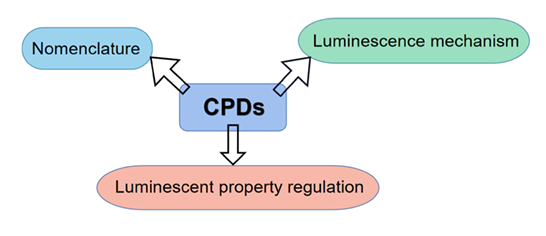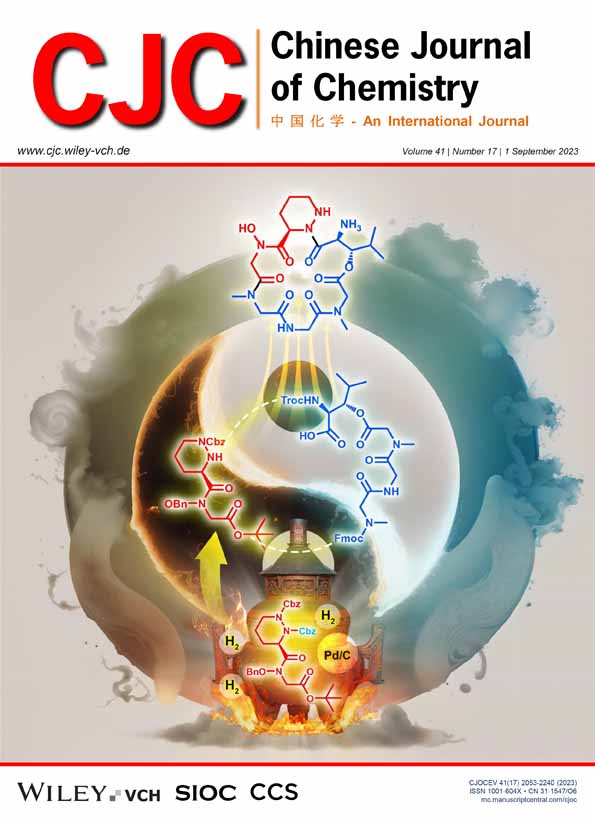The Classification of Carbon Dots and the Relationship between Synthesis Methods and Properties
Xin-Xiang Zhao
State Key Laboratory of Supramolecular Structure and Materials, College of Chemistry, Jilin University, Changchun, Jilin, 130012 China
Search for more papers by this authorSong-Yuan Tao
State Key Laboratory of Supramolecular Structure and Materials, College of Chemistry, Jilin University, Changchun, Jilin, 130012 China
Search for more papers by this authorCorresponding Author
Bai Yang
State Key Laboratory of Supramolecular Structure and Materials, College of Chemistry, Jilin University, Changchun, Jilin, 130012 China
E-mail: [email protected]Search for more papers by this authorXin-Xiang Zhao
State Key Laboratory of Supramolecular Structure and Materials, College of Chemistry, Jilin University, Changchun, Jilin, 130012 China
Search for more papers by this authorSong-Yuan Tao
State Key Laboratory of Supramolecular Structure and Materials, College of Chemistry, Jilin University, Changchun, Jilin, 130012 China
Search for more papers by this authorCorresponding Author
Bai Yang
State Key Laboratory of Supramolecular Structure and Materials, College of Chemistry, Jilin University, Changchun, Jilin, 130012 China
E-mail: [email protected]Search for more papers by this authorComprehensive Summary
The carbon dots (CDs), as emerging carbon based nanomaterials, are a kind of fluorescent materials with wide application prospects. Highly luminous CDs can simply be synthesized by a wide variety of easily accessible precursors. CDs have excellent optical properties, high biocompatibility and low toxicity, which makes them be used in the fields of optics, biology, energy, and so on. In this review, the classification, nomenclature, photoluminescence mechanism and property regulation of CDs are reviewed. Finally, the future research interests and potential challenges of CDs are prospected.
References
- 1 Xu, X. Y.; Ray, R.; Gu, Y. L.; Ploehn, H. J.; Gearheart, L.; Raker, K.; Scrivens, W. A. Electrophoretic Analysis and Purification of Fluorescent Single-Walled Carbon Nanotube Fragments. J. Am. Chem. Soc. 2004, 126, 12736–12737.
- 2 Zhu, S. J.; Song, Y. B.; Zhao, X. H.; Shao, J. R.; Zhang, J. H.; Yang, B. The Photoluminescence Mechanism in Carbon Dots (Graphene Quantum Dots, Carbon Nanodots, and Polymer Dots): Current State and Future Perspective. Nano Res. 2015, 8, 355–381.
- 3 Zhu, S. J.; Song, Y. B.; Shao, J. R.; Zhao, X. H.; Yang, B. Non-Conjugated Polymer Dots with Crosslink Enhanced Emission in the Absence of Fluorophore Units. Angew. Chem. Int. Ed. 2015, 54, 14626–14637.
- 4 Xia, C. L.; :Zhu, S. J.; Feng, T. L.; Yang, M. X.; Yang, B. Evolution and Synthesis of Carbon Dots: From Carbon Dots to Carbonized Polymer Dots. Adv. Sci. 2019, 6, 1901316.
- 5 Li, X. M.; Rui, M. C.; Song, J. Z.; Shen, Z. H.; Zeng, H. B. Carbon and Graphene Quantum Dots for Optoelectronic and Energy Devices: A Review. Adv. Funct. Mater. 2015, 25, 4929–4947.
- 6 Ai, L.; Yang, Y. S.; Wang, B. Y.; Chang, J. B.; Tang, Z. Y.; Yang, B.; Lu, S. Y. Insights into Photoluminescence Mechanisms of Carbon Dots: Advances and Perspectives. Sci. Bull. 2021, 66, 839–856.
- 7 Kang, C. Y.; Tao, S. Y.; Yang, F.; Yang, B. Aggregation and Luminescence in Carbonized Polymer Dots. Aggregate 2022, 3, e169.
- 8
Zeng, C. Y.; Tao, S. Y.; Yang, B. Polymer-Structure-Induced Room-Temperature Phosphorescence of Carbon Dot Materials. Small Struct. 2023, 2200327.
10.1002/sstr.202200327 Google Scholar
- 9 Tao, S. Y.; Zeng, C. Y.; Kang, C. Y.; Zhu, S. J.; Feng, T. L.; Zhang, S. T.; Ding, Z. Y.; Zeng, C. Y.; Xia, C. L.; Yang, B. Confined-Domain Crosslink-Enhanced Emission Effect in Carbonized Polymer Dots. Light: Sci. Appl. 2022, 11, 56.
- 10 Tao, S. Y.; Feng, T. L.; Zheng, C. Y.; Zhu, S. J.; Yang, B. Carbonized Polymer Dots: A Brand New Perspective to Recognize Luminescent Carbon-Based Nanomaterials. J. Phys. Chem. Lett. 2019, 10, 5182–5188.
- 11 Zeng, Q. S.; Feng, T. L.; Tao, S. Y.; Zhu, S. J.; Yang, B. Precursor-Dependent Structural Diversity in Luminescent Carbonized Polymer Dots (CPDs): the Nomenclature. Light: Sci. Appl. 2021, 10, 142.
- 12 Sun, H. Z.; Yang, G. D.; Yang, B. Synthesis, Structure Control and Applications of Carbon Dots. Chem. Res. Chin. Univ. 2021, 2, 349–365.
- 13 Liu, J. J.; Li, R.; Yang, B. Carbon Dots: A New Type of Carbon-Based Nanomaterial with Wide Applications. ACS Cent. Sci. 2020, 6, 2179–2195.
- 14 Liu, J.; Kong, T. Y.; Xiong, H. M. Mulberry-Leaves-Derived Red-Emissive Carbon Dots for Feeding Silkworms to Produce Brightly Fluorescent Silk. Adv. Mater. 2022, 34, 2200152.
- 15 Xia, C. L.; Tao, S. Y.; Zhu, S. J.; Song, Y. B.; Feng, T. L.; Zeng, Q. S.; Liu, J. J.; Yang, B. Hydrothermal Addition Polymerization for Ultrahigh-Yield Carbonized Polymer Dots with Room Temperature Phosphorescence via Nanocomposite. Chem. - Eur. J. 2018, 24, 11303–11308.
- 16 Dong, Y. Q.; Pang, H. C.; Yang, H. B.; Guo, C. X.; Shao, J. W.; Chi, Y. W.; Li, C. M.; Yu, T. Carbon-Based Dots Co-Doped with Nitrogen and Sulfur for High Quantum Yield and Excitation-Independent Emission. Angew. Chem. Int. Ed. 2013, 52, 7800–7804.
- 17 Huang, J.; Chen, Y. Q.; Rao, P. P.; Ni, Z. M.; Chen, X. Y.; Zhu, J.; Li, C.; Xiong, G. Y.; Liang, P.; He, X.; Qu, S. N.; Lin, J. Enhancing the Electron Transport, Quantum Yield, and Catalytic Performance of Carbonized Polymer Dots via Mn-O Bridges. Small 2022, 18, 2106863.
- 18
Lu, S. Y.; Sui, L. Z.; Wu, M.; Zhu, S. J.; Yong, X.; Yang, B. Graphitic Nitrogen and High-Crystalline Triggered Strong Photoluminescence and Room-Temperature Ferromagnetism in Carbonized Polymer Dots. Adv. Sci. 2019, 6, 1801192.
10.1002/advs.201801192 Google Scholar
- 19 Ding, H.; Yu, S. B.; Wei, J. S.; Xiong, H. M. Full-Color Light-Emitting Carbon Dots with a Surface-State-Controlled Luminescence Mechanism. ACS Nano 2016, 10, 484–491.
- 20 Liu, B.; Chu, B.; Wang, Y. L.; Hu, L. F.; Hu, S. L.; Zhang, X. H. Carbon Dioxide Derived Carbonized Polymer Dots for Multicolor Light-Emitting Diodes. Green Chem. 2021, 23, 422–429.
- 21 Ding, H.; Wei, J. S.; Zhang, P.; Zhou, Z. Y.; Gao, Q. Y.; Xiong, H. M. Solvent-Controlled Synthesis of Highly Luminescent Carbon Dots with a Wide Color Gamut and Narrowed Emission Peak Widths. Small 2018, 14, 1800612.
- 22 Wang, X.; Yang, H.; Zuo, D. Y.; Xu, J.; Zhang, H. W. A Versatile and Facile Strategy for Full-Color Emitting Carbonized Polymer Dots. J. Nanopart. Res. 2021, 23, 250.
- 23 Liu, Y.; Chen, W. H.; Lu, L. H.; Yang, B. Si-Assisted N, P Co-Doped Room Temperature Phosphorescent Carbonized Polymer Dots: Information Encryption, Graphic Anti-Counterfeiting and Biological Imaging. J. Colloid Interface Sci. 2022, 609, 279–288.
- 24 Tao, S. Y.; Zhu, S. J.; Feng, T. L.; Xia, C. L.; Song, Y. B.; Yang, B. The Polymeric Characteristics and Photoluminescence Mechanism in Polymer Carbon Dots: A review. Mater. Today Chem. 2017, 6, 13–25。
- 25 Song, Y. B.; Zhu, S. J.; Zhang, S. T.; Fu, Y.; Wang, L.; Zhao, X. H.; Yang, B. Investigation from Chemical Structure to Photoluminescent Mechanism: a Type of Carbon Dots from the Pyrolysis of Citric Acid and an Amine. J. Mater. Chem. C 2015, 3, 5976–5984.
- 26 Zhu, S. J.; Zhao, X. H.; Song, Y. B.; Lu, S. Y.; Yang, B. Beyond Bottom-up Carbon Nanodots: Citric-Acid Derived Organic Molecules. Nano Today 2016, 11, 128–132.
- 27 Schneider, J.; Reckmeier, C. J.; Xiong, Y.; Seckendorff, M. V.; Susha, A. S.; Kasak, P.; Rogach, A. L. Molecular Fluorescence in Citric Acid-Based Carbon Dots. J. Phys. Chem. C 2017, 121, 2014–2022.
- 28 Zhang, X.; Geng, Y. J.; Tao, S. Y.; Xu, S. P.; Xu, W. Q. Main Luminescent Centers of Carbonized Polymer Dots. Chem. J. Chinese Universities 2019, 40, 2521–2525.
- 29 Zhu, S. J.; Wang, L.; Zhou, N.; Zhao, X. H.; Song, Y. B.; Maharjan, S.; Zhang, J. H.; Lu, L. J.; Wang, H. Y.; Yang, B. The Crosslink Enhanced Emission (CEE) in Non-Conjugated Polymer Dots: from the Photoluminescence Mechanism to the Cellular Uptake Mechanism and Internalization. Chem. Commun. 2014, 50, 13845–13848.
- 30 Tao, S. Y.; Zhu, S. J.; Feng, T. L.; Zeng, C. Y.; Yang, B. Crosslink-Enhanced Emission Effect on Luminescence in Polymers: Advances and Perspectives. Angew. Chem. Int. Ed. 2020, 59, 9826–9840.
- 31 Wang, B. Y.; Lu, S. Y. The Light of Carbon Dots: From Mechanism to Applications. Matter 2022, 5, 110–149.
- 32 Jiang, K.; Wang, Y. H.; Cai, C. Z.; Lin, H. W. Conversion of Carbon Dots from Fluorescence to Ultralong Room-Temperature Phosphorescence by Heating for Security Applications. Adv. Mater. 2018, 30, 1800783.
- 33 Lv, G.; Wang, Z. W.; Li, W. J.; Zhu, G. N.; Liu, B. B.; Song, B.; Wu, M.; Gong, X. Acid-Regulated Boron-Nitrogen Codoped Multicolor Carbonized Polymer Dots and Applications for pH Sensing and Trace Water Detection. Nanoscale 2022, 14, 12762–12772.
- 34 Wan, J. F.; Zhang, X.; Jing, Y.; Xu, S. Q.; Li, J.; Yu, M. L.; Zhang, K.; Su, Z. Q. Regulation of Multi-Color Fluorescence of Carbonized Polymer Dots by Multiple Contributions of Effective Conjugate Size, Surface State, and Molecular Fluorescence. J. Mater. Chem. B 2022, 10, 6991–7002.
- 35 Krysmann, M. J.; Kelarakis, A.; Dallas, P.; Giannelis, E. P. Formation Mechanism of Carbogenic Nanoparticles with Dual Photoluminescence Emission. J. Am. Chem. Soc. 2012, 134, 747–750.
- 36 Ru, Y.; Sui, L. Z.; Song, H. Q.; Liu, X. J.; Tang, Z. Y.; Zang, S. Q.; Yang, B.; Lu, S. Y. Rational Design of Multicolor-Emitting Chiral Carbonized Polymer Dots for Full-Color and White Circularly Polarized Luminescence. Angew. Chem. Int. Ed. 2021, 60, 14091–14099.
- 37 Lu, S. Y.; Cong, R. D.; Zhu, S. J.; Zhao, X. H.; Liu, S. Y.; Tse, J. S. Meng, S.; Yang, B. pH-Dependent Synthesis of Novel Structure-Controllable Polymer Carbon NanoDots with High Acidophilic Luminescence and Super Carbon Dots Assembly for White Light-Emitting Diodes. ACS Appl. Mater. Interfaces 2016, 8, 4062–4068.
Citing Literature
1 September, 2023
Pages 2206-2216




